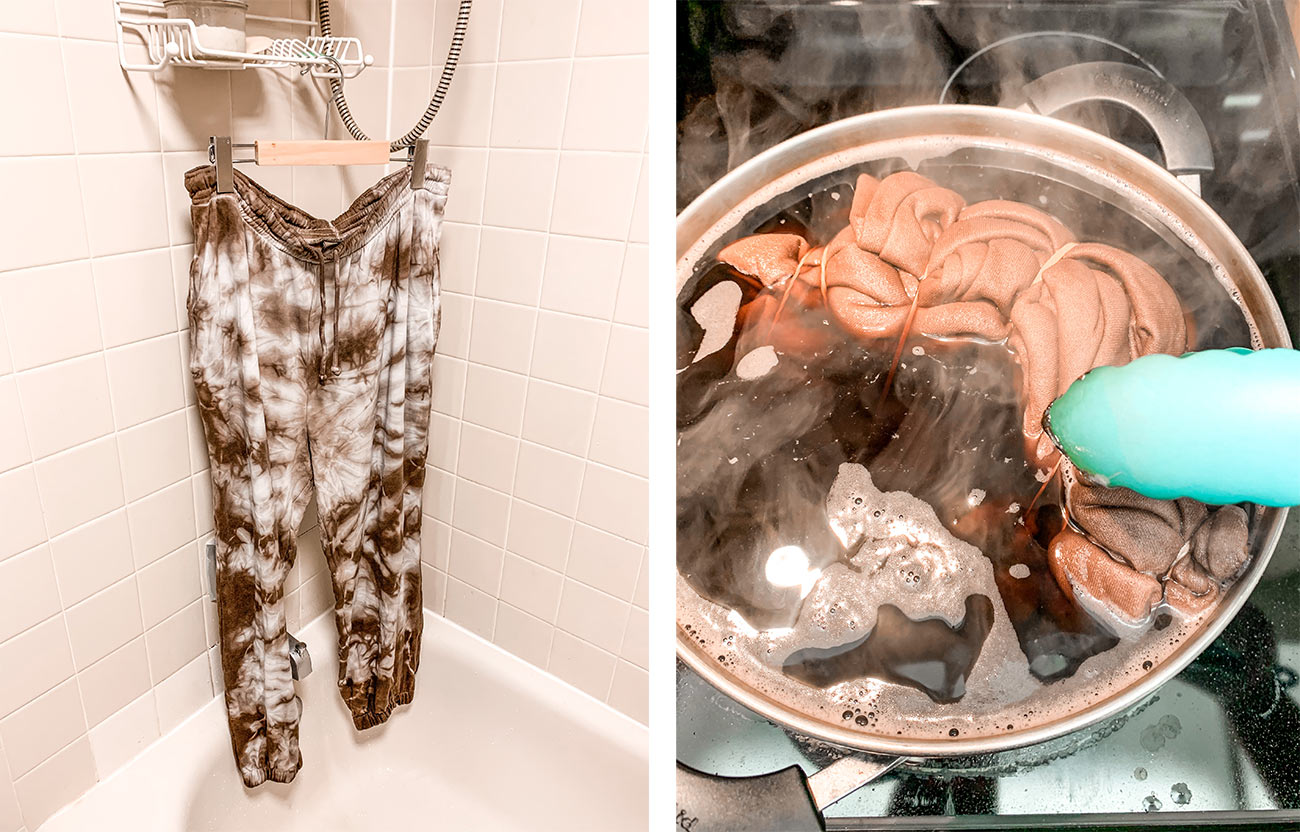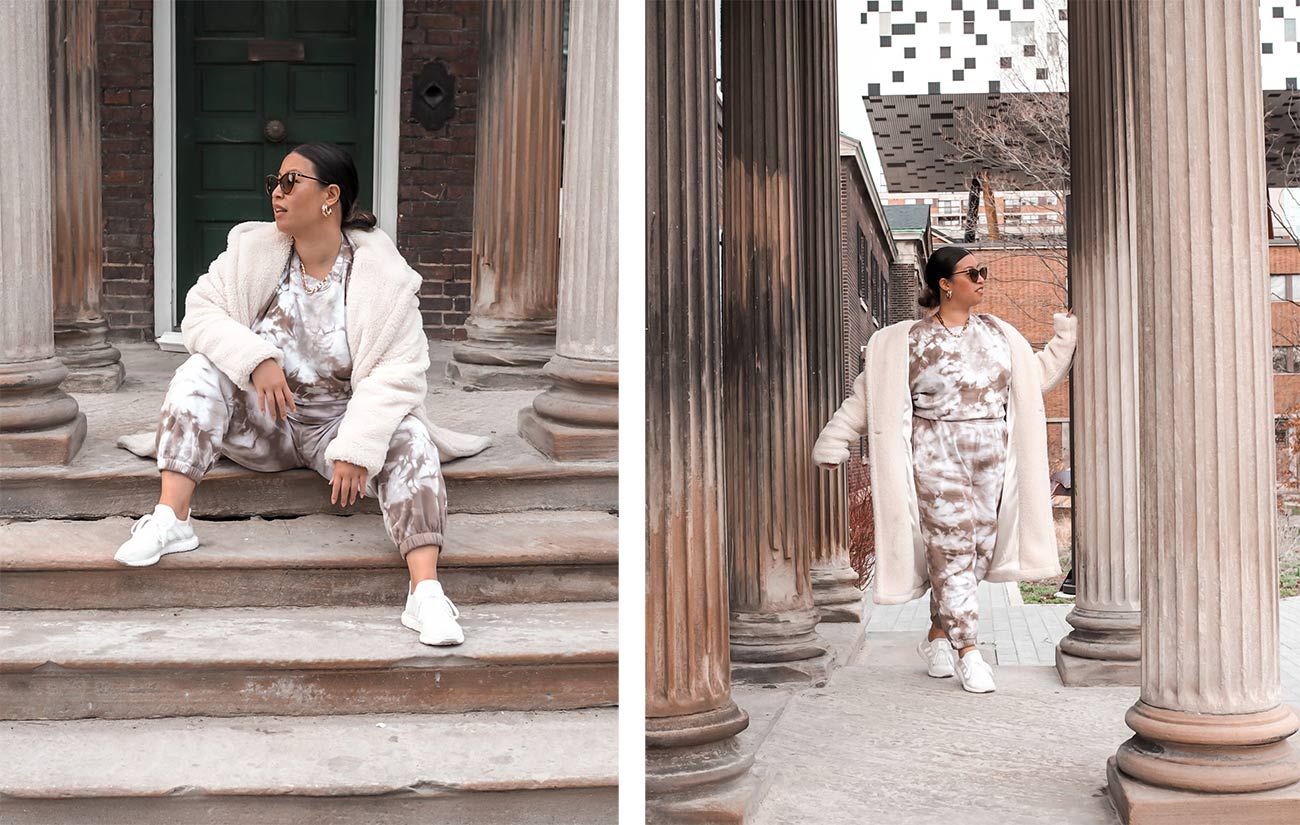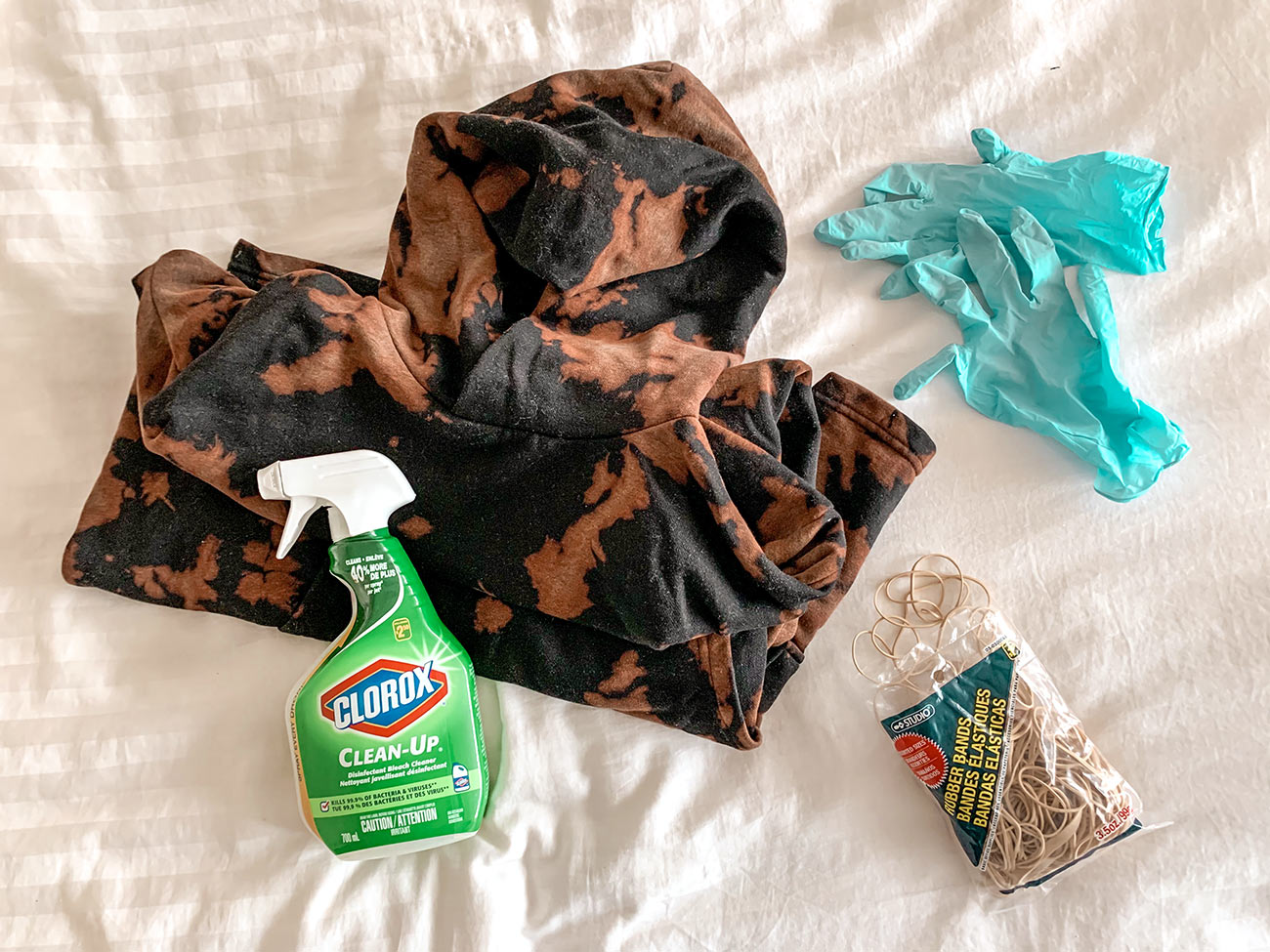
Considering how disastrous my first attempt to tie dye sweatpants went, I’m the last person who should be doling out tips on this trendy lockdown activity. Or perhaps failing so miserably makes me MORE qualified to dispense some very hard-earned wisdom…🤔
You’d think that as an art school graduate that I’d have some innate knack for crafty pursuits, but I’m shockingly horrible. I struggled to secure the clothing items with elastic bands, the dye wouldn’t take, the material came out of the washer exactly the way it was to begin with…
I started to wonder: Should I throw in the towel and buy a ready-made tie dye set instead?

That’s when my stubbornness kicked in. With a single-minded tenacity that some would label “obsessive,” I read various in-depth tie dye instruction posts and watched countless tutorials until I mastered the art of tie dye*.
In the end, it was supremely satisfying to be able to customize my jogger set to my exact aesthetic taste.
All that failure was worth it because now I can help set YOU (dear reader) up for tie dye success!
*I am being hyperbolic for dramatic effect

RELATED READING:
➳ 7 Things I Learned From Building A Website From Scratch
➳ 6 Easy Indoor Plants To Turn Your Home Into A Jungle
➳ 7 Types of Journals To Start Based On Your Vibes
Please note: This page contains affiliate links, meaning I may earn a commission if you make a purchase by clicking a link (at no extra cost to you)
If you’re going to attempt to tie dye sweatpants and want to avoid the aforementioned frustration, read on for tips and tricks to help the process run smoothly.
What You Need To Know Before You Tie Dye Sweatpants:
Washing
Whether you’re attempting to tie dye sweatpants or an entire jogger set, your washing machine will be getting quite the workout.

Before you do anything else, you should prewash your clothing. It will remove dirt, stains, and treatments that prevent the dye from absorbing properly such as sizing (product used to keep fabric stiff and minimize wrinkles).
Damp fabric is more ideal for saturating so wash items just before you plan on tie dyeing.
Once you’ve dyed your items, rinse them — first under warm water, then cold — until the water runs clear. Then you can throw it in the washing machine for a second time. ALONE. This is unless you want your other clothes to be mottled with the dye.
You can put in an old towel in with the freshly dyed fabric to soak up any residual dye or run an empty cycle after with some bleach to rinse your machine afterwards.
Fabric Matters
What frustrated me to no end was that very few tutorials I found on YouTube addressed exactly what kind of fabric was required to tie dye sweatpants. They made it sound like a non-issue, like you could just use any old white duds you happened to have laying around.

After several failed attempts, I can tell you, that this is not the case. The material you use is CRUCIAL because it will dictate everything, from the type of dye you use to how long you let it sit to the method of tie dying.
Let me break it down for you: Natural fibres like cotton, linen and silk soaks up and retains dye easily BUT it is hard AF to find 100% cotton sweats at a reasonable price point. This one actually has a high cotton content if you’re ok with a little logo.

You are more likely to find cotton synthetic blends but it needs to have 35% or less synthetic material (also difficult to find) to dye with a regular dye.
The lowest synthetic blend I found was 60% cotton and 40% polyester like this sweatshirt and sweatpants from H&M. This sweatshirt and this sweatshirt are also great options (50% cotton, 50% polyester) and will have a nice over-sized fit.
Items made entirely of synthetic material won’t absorb the dye, or at the very least it’s much harder. I tried saturating polyester with a synthetic fabric dye and the colour still completely washed out. This material requires the stovetop method (read on below) to absorb colour.
Method
Most online tutorials demonstrated how to tie dye jogger sets using the spot tie dyeing method…which is great if you somehow knew to use clothes made of natural fibres.
Using a bottle (like these) with the dye mixture, you douse the clothing (bundled with elastics) then let it sit for at least 20 minutes (I’d probably leave it overnight to be safe). To ensure you have enough of the same colour mixture, make a larger batch in a jug before pouring into smaller bottles.
It’s recommended to steam the clothing and use a colour fixative to enhance the colours and keep it from bleeding upon being washed. It’s not necessary as far as I can tell but if you’re extra anxious, it can’t hurt!

Note that the dye will look darker when the fabric is wet but will lighten and fade as you wash and dry.
For fabrics that contain more than 35% synthetic material, it’s recommended to use the stovetop method as heat helps the fabric to absorb the dye.
The process is exactly how it sounds — using a stainless steel pot that’s large enough to fit your piece, you heat the water with some dish soap until it’s just before boiling (about 200 degrees), mix in the dye and add your clothes.

If you have a smaller pot, you’ll have to tie dye sweatpants or your jogger set one item at a time for 30 minutes to an hour each, depending on how dark you want it.
Colour palette
The first thing that comes to mind for “tie dye jogger set” is a gaudy explosion of colours that you’d expect to experience while tripping on some intense drugs. Depending on which colours are used and how they mix, it can turn an already busy pattern into a muddy mess!
But how do you update this nostalgic trend for modern style? Try monochrome tie dye! Limiting your tie dye sweatpants colour palette to a single hue will make your formerly unkept WFH uniform super chic.


Not bad for my first (successful) attempt!
What’s more aesthetically pleasing than a neutral tie dye jogger set? Try tan, blush tones, light blue for a subtle cloud pattern….the sky’s the limit (see what I did there?).
For above set, I used the stovetop method with this sweatshirt and sweatpants from H&M (60% cotton, 40% polyester) and 1 tablespoon each of Rit Dyemore Sand Stone and Chocolate Brown. I left each item in the near-boiling bath for 50 minutes, but take it out sooner or use less dye if you want it to be lighter.

Tie Dye Sets from Wild Rina
If you just want to throw money at the problem, I don’t blame you. I’m obsessed with these soft pastel jogger sets from Wild Rina.
For a more budget-friendly option, this lounge wear set is highly rated.
Tie Dye Techniques
When I refer to technique, I mean the pattern that you tie dye your jogger set, t-shirt, or whatever strikes your fancy.

My horribly imperfect attempt at the crinkle technique
Here are some popular tie dye patterns that you can try:
+ Crinkle Tie Dye: This is the most common and probably the easiest method. You simply gather or crinkle your material up into little folds and secure elastic bands as needed. Don’t get hung up on perfection since it’s pretty hard to mess up.
+ Ice Tie Dye: To achieve a more organic aesthetic with a water effect, try this technique of sprinkling powdered dye on top of ice that’s on crumpled fabric. As it’s cold, this will only work with natural fibres and certain colours may turn out lighter.
+ Spiral Tie Dye: For a trippy spiral graphic instead of crumpling the fabric, use a large fork to twirl it into a circular shape before securing elastics around evenly.
+ Shibori Tie Dye: This style originates from Japan and involves folding, bunching and twisting the fabric with various techniques — kanoko, itajime, arashi — to create patterns. It’s traditionally done with indigo dye but you can use whatever hue you prefer. There are even shibori tie dye kits that will save you time gathering the items needed.
+ Ombré Tie Dye: Meaning “to shade” in French, the ombré method is done by gradating the colour from light to dark. Using material made of natural fibres, you can space out elastics along your item and saturate the sections in the dye mixture, watering it down as you move along to each area to create the lightening effect.
bleach tie dye
If the prospect of tie dying sweatpants — let alone an entire jogger set — is intimidating, I hear you.
Luckily for those of you who still want to hop on the tie dye trend, you can try reverse tie dye. Instead of adding colour, this method removes it, using a product you most likely already have in your home — bleach.

Not only will it work on any fabric but it eliminates the need for dye.
Combine one part water and one part bleach in a bottle (spray or otherwise) and thoroughly douse your black or coloured clothing, trussed up as you would for regular tie dying. You’ll see the colour start changing immediately.
Depending on how light you want the fabric to get, you can leave it on from 8 minutes to an hour. I even saw a tutorial where someone left it overnight and the fabric had gone completely white! But that probably depends on what colour the material was originally.

Don’t forget to wear gloves to protect your hands and either do it outside or in a well-ventilated area so you don’t breathe in the chemicals. Ideally, reverse tie dye is done in a sink, tub or bucket…something the bleach won’t eat through.
I personally used a Clorox bleach spray on this black hoodie sweater dress for 30 minutes, resulting in this bronze/orange tie dye hue. If I left it overnight, maybe it would’ve stripped more of the black away but I was afraid the bleach would eat away at the fabric and create holes.

Quite frankly, I was obsessed with the reverse tie dye result
This Hanes crewneck sweatshirt would also work. It’s high quality but inexpensive in case you’re nervous about ruining your clothes.
What You Need to Tie Dye Sweatpants:
✧ White Sweatpants or Clothes
✧ Elastic Bands
✧ Regular Dye or Dye for Synthetic Fabrics
✧ Dish Soap
✧ Rubber Gloves
✧ Old Towel (to test dye)
✧ Bottles (like these if you’re doing spot dye)
Was attempting to tie dye sweatpants a huge pain in my ass? Emphatically YES! However, with my mild obsessive tendencies (especially when it comes to aesthetics), I found it supremely satisfying to be able to customize my jogger set to exactly my taste. Plus I feel pretty proud of myself for sticking with it. Now excuse me while I go tie dye everything in my closet…
Looking for another project that will improve your WFH experience? Check out how you can transform your bedroom into a calm oasis.
Keep your stalking game strong and follow me @teriaki if you aren’t already!








0 Comments